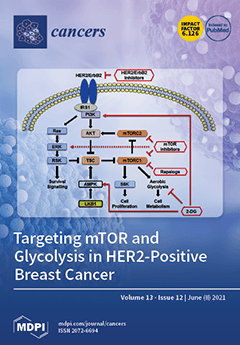Objectives: Patients with epidermal growth factor receptor (
EGFR) mutant non-small cell lung cancer (NSCLC) ultimately acquire resistance to
EGFR tyrosine kinase inhibitors (TKIs) during treatment. In 5–22% of these patients, resistance is mediated by aberrant mesenchymal epithelial transition factor (
MET
[...] Read more.
Objectives: Patients with epidermal growth factor receptor (
EGFR) mutant non-small cell lung cancer (NSCLC) ultimately acquire resistance to
EGFR tyrosine kinase inhibitors (TKIs) during treatment. In 5–22% of these patients, resistance is mediated by aberrant mesenchymal epithelial transition factor (
MET) gene amplification. Here, we evaluated the emergence of
MET amplification after EGFR-TKI treatment failure based on clinical parameters. Materials and Methods: We retrospectively analyzed 186 patients with advanced
EGFR-mutant NSCLC for
MET amplification status by in situ hybridization (ISH) assay after EGFR-TKI failure. We collected information including baseline patient characteristics, metastatic locations and generation, line, and progression-free survival (PFS) of EGFR-TKI used before
MET evaluation. Multivariate logistic regression analysis was conducted to evaluate associations between
MET amplification status and clinical variables. Results: Regarding baseline
EGFR mutations, exon 19 deletion was predominant (57.5%), followed by L858R mutation (37.1%). The proportions of
MET ISH assays performed after first/second-generation and third-generation TKI failure were 66.7% and 33.1%, respectively. The median PFS for the most recent EGFR-TKI treatment was shorter in
MET amplification-positive patients than in
MET amplification-negative patients (median PFS 7.0 vs. 10.4 months,
p = 0.004). Multivariate logistic regression demonstrated that a history of smoking, short PFS on the most recent TKI, and less intracranial progression were associated with a high probability of
MET amplification (all
p < 0.05). Conclusions: Our results demonstrated the distinct clinical characteristics of patients with
MET amplification-positive NSCLC after EGFR-TKI therapy. Our clinical prediction can aid physicians in selecting patients eligible for
MET amplification screening and therapeutic targeting.
Full article






